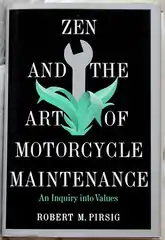Zen and the Art of Motorcycle Maintenance
Zen and the Art of Motorcycle Maintenance (or to give you its full title, Zen and the Art of Motorcycle Maintenance: An Inquiry into Values, but we will refer to it as "ZAMM" because that sounds cool) is a novel by Robert M. Pirsig

| This might be Skepticism |
| But we're not sure |
| Who's asking? |
|
v - t - e |
| —Flyleaf disclaimer. |
Impact
The book was published in 1974 and became a global bestseller, selling over five million copies. It remains popular to this very day with:
- Rational people who have actually read the book
- New agers, hippies and other woo-philes who own the book but haven't actually read it
The book remains very unpopular with:
- Rational people who were led to believe that the book was about "new age spiritualism"
- New agers, hippies and other woo-philes who actually did read the book and realized it has nothing to do with "new age spiritualism," and in fact it pretty much ridicules it
What ZAMM is about
The primary source of all the misunderstandings about ZAMM is the fact that its central thesis is about "trying to find a way to harmonize the rational with the irrational", which Pirsig termed his "metaphysics of quality." Unfortunately the hippies of the day interpreted his use of the word "irrational" as implying it was perfectly cool to believe just about any bit of wild-eyed nonsense and simply declare that it was "quality".
However Pirsig did not use the term "irrational" to mean anything remotely like "ancient wisdom" or "supernatural forces". He specifically identified the "irrational" as being the subjective side of the human experience, which includes things like aesthetics, creativity and impulsiveness (i.e., unstructured decision making). In his jargon, the human capacity for creativity and intuition are beyond "rational" analysis, which thus makes them "irrational". Unfortunately he did not make this distinction clear until about page five, and most people never read that far.
Pirsig labels the subjective view of the world as the "Romantic" viewpoint, and contrasts this with his own analytic, objective view of the world (which he labels the "Classical" viewpoint). As he narrates, it becomes clear he feels he personally gives too much emphasis to his analytic viewpoint, and that his companion looks at everything from too much of a subjective perspective.
He uses the motorcycle as an object of study. His companion is enamored with the image of freedom and individualism that he associates with owning a motorcycle, but is repelled by the intricate details of its operation. In contrast Pirsig is obsessed with the details of motorcycle maintenance, and regards the intricate design of all the moving parts as a thing of great beauty. Through the philosophical wrangling that follows, he attempts to devise a worldview which harmonizes these conflicting perspectives, borrowing heavily from the ancient Greek philosophers along the way.
The book also has nothing to do with Zen Buddhism or "Eastern wisdom". Pirsig used the Zen concept of "being in the present" as a symbol of his theory that one can unite subjectivity and objectivity into a personal worldview, and achieve a greater level of happiness as a result. He got to this idea because his original obsessive attempts to analyze "quality" resulted in him being committed to an insane asylum, and he eventually figured out that maybe "living in the moment", combined with reason and sound judgment, isn't such a bad thing.
Assessment
ZAMM is enjoyable and thought-provoking, though it gets heavy going in the middle, with an enormous amount of time devoted to Plato and Aristotle. It's unfortunate that a book which is so heavily based in rational thought is popularly associated with the New Age movement, a phenomenon the author himself decries. The closest ZAMM ever comes to any new age idea is a section where Pirsig ponders on how mythology and folklore arise and persist in tribal cultures such as the Native Americans, and how those beliefs fare in the modern age.
Like any book of philosophy, there is plenty in ZAMM for any rational person to think about and potentially disagree with. If you disagree with his premise that creativity is fundamentally an "irrational" process, then you're probably going to find a lot to disagree with. However from a rationalist point of view, ZAMM is firmly grounded in reason and the human experience, and certainly makes no appeals to any mystical or supernatural forces, so it deserves far more respect than it tends to get as a result of its (undeserved) reputation as a "woo" book.
However, a slightly woo-ish narrative was added as an afterword to later editions of the book, in which Pirsig relates how his son, Chris, the model for the book's character of that name, was murdered in San Francisco in 1979 (ironically, just outside the Zen Center). Shortly thereafter, Pirsig's wife became pregnant with his daughter, Nell; their first instinct was to get an abortion, but as they discussed it, Pirsig had a dissociative episode, which he interpreted as a sign that Nell was the reincarnation of Chris, and they eventually decided against it. (pp. 538-539)
See also
- Apollonian and Dionysian
- The Celestine Prophecy, a 1993 book from a similar mold
- Alan Watts